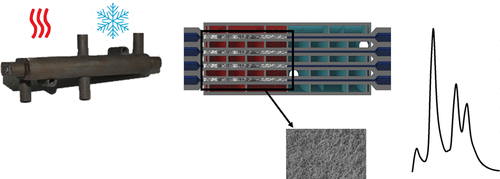当前位置:
X-MOL 学术
›
Anal. Chem.
›
论文详情
Our official English website, www.x-mol.net, welcomes your
feedback! (Note: you will need to create a separate account there.)
Confinement of Monolithic Stationary Phases in Targeted Regions of 3D-Printed Titanium Devices Using Thermal Polymerization.
Analytical Chemistry ( IF 6.7 ) Pub Date : 2020-01-13 , DOI: 10.1021/acs.analchem.9b04298 Marta Passamonti 1, 2 , Ischa L Bremer 1 , Suhas H Nawada 1, 2 , Sinéad A Currivan 1, 3 , Andrea F G Gargano 1, 2 , Peter J Schoenmakers 1, 2
Analytical Chemistry ( IF 6.7 ) Pub Date : 2020-01-13 , DOI: 10.1021/acs.analchem.9b04298 Marta Passamonti 1, 2 , Ischa L Bremer 1 , Suhas H Nawada 1, 2 , Sinéad A Currivan 1, 3 , Andrea F G Gargano 1, 2 , Peter J Schoenmakers 1, 2
Affiliation

|
In this study, we have prepared thermally initiated polymeric monolithic stationary phases within discrete regions of 3D-printed titanium devices. The devices were created with controllable hot and cold regions. The monolithic stationary phases were first locally created in capillaries inserted into the channels of the titanium devices. The homogeneity of the monolith structure and the interface length were studied by scanning a capacitively coupled conductivity contactless detector (C4D) along the length of the capillary. Homogeneous monolithic structures could be obtained within a titanium device equipped with a hot and cold jacket connected to two water baths. The confinement method was optimized in capillaries. The sharpest interfaces (between monolith and empty channel) were obtained with the hot region maintained at 70 °C and the cold region at 4 or 10 °C, with the latter temperature yielding better repeatability. The optimized conditions were used to create monoliths bound directly to the walls of the titanium channels. The fabricated monoliths were successfully used to separate a mixture of four intact proteins using reversed-phase liquid chromatography. Further chromatographic characterization showed a permeability (Kf) of ∼4 × 10-15 m2 and a total porosity of 60%.
中文翻译:

使用热聚合将整体固定相限制在 3D 打印钛器件的目标区域中。
在这项研究中,我们在 3D 打印钛器件的离散区域内制备了热引发聚合物整体固定相。这些设备具有可控的热区和冷区。首先在插入钛装置通道的毛细管中局部产生整体固定相。通过沿着毛细管的长度扫描电容耦合电导率非接触式检测器(C4D)来研究整体结构的均匀性和界面长度。可以在配备有连接到两个水浴的冷热夹套的钛装置内获得均匀的整体结构。在毛细血管中优化了限制方法。最清晰的界面(整体和空通道之间)是在热区域保持在 70 °C 和冷区域保持在 4 或 10 °C 时获得的,后者的温度产生更好的重复性。使用优化的条件来创建直接粘合到钛通道壁上的整体材料。使用反相液相色谱法,所制造的整体材料成功地用于分离四种完整蛋白质的混合物。进一步的色谱表征显示渗透率 (Kf) 约为 4 × 10-15 m2,总孔隙率为 60%。
更新日期:2020-01-13
中文翻译:

使用热聚合将整体固定相限制在 3D 打印钛器件的目标区域中。
在这项研究中,我们在 3D 打印钛器件的离散区域内制备了热引发聚合物整体固定相。这些设备具有可控的热区和冷区。首先在插入钛装置通道的毛细管中局部产生整体固定相。通过沿着毛细管的长度扫描电容耦合电导率非接触式检测器(C4D)来研究整体结构的均匀性和界面长度。可以在配备有连接到两个水浴的冷热夹套的钛装置内获得均匀的整体结构。在毛细血管中优化了限制方法。最清晰的界面(整体和空通道之间)是在热区域保持在 70 °C 和冷区域保持在 4 或 10 °C 时获得的,后者的温度产生更好的重复性。使用优化的条件来创建直接粘合到钛通道壁上的整体材料。使用反相液相色谱法,所制造的整体材料成功地用于分离四种完整蛋白质的混合物。进一步的色谱表征显示渗透率 (Kf) 约为 4 × 10-15 m2,总孔隙率为 60%。









































 京公网安备 11010802027423号
京公网安备 11010802027423号